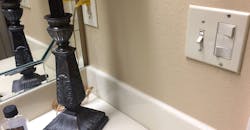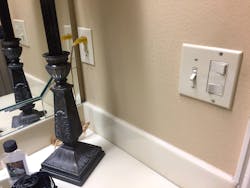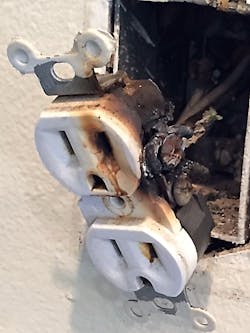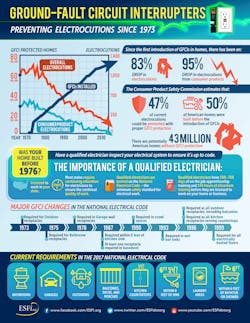Why Educating Homeowners on GFCIs Matters
Things that we as inspectors and electricians take for granted, such as ground-fault circuit-interrupter (GFCI) protection, may be foreign to the average homeowner. Does the homeowner really understand the purpose of a GFCI device? We also know that installation requirements change every time the National Electrical Code (NEC) is revised or adopted by the state or local municipality. But does the homeowner really understand where these devices are required by the NEC? Do they even know the NEC exists, not to mention which edition is currently enforced within their state or municipality? These questions can lead to some interesting situations when homeowners take matters into their own hands.
Some homeowners are comfortable making an occasional repair to their electrical system. They see the challenge associated with changing out a non-working switch or receptacle worthwhile and a money-saving option to hiring a licensed electrical contractor to complete this type of work. Most of these individuals have a desire to do good work as it is something that could harm them or their family members if not done properly.
Most laws allow homeowners to conduct electrical work associated with their main residence, although there is typically a limit as to what can be done without a permit or an inspection. But as we know, before beginning any type of electrical project, the homeowner should contact his or her local electrical inspection department to find out the specifics to making home repairs to an electrical system.
Let’s take an example of a homeowner who finds out the receptacle in the bathroom no longer functions (Photo 1 and Photo 2). The home, which was constructed in 1965, had been in the family for years. The family had taken great pride to make the necessary repairs during the life of the home to keep it functioning and in good condition.
The homeowner turned off the circuit breaker to the receptacle in the bathroom, had a voltmeter handy, and checked for the absence of electricity. With the receptacle removed and in hand, he was off to the hardware store to find another receptacle. After finding an identical receptacle, he installed the unit and turned the circuit breaker back on. The lamp on the counter was plugged back in, and everything appeared to be back to normal.
In the homeowner’s mind, the repair had been completed safely and in a Code-compliant manner. But is that true? In this case, that answer is no. After the DIY installation, the homeowner knows the receptacle is working properly but is unaware it needs to be GFCI protected to be compliant with today’s NEC. See Sec. 406.4(D)(3) in the 2017 NEC for GFCI receptacle replacement requirements.
The following week, a hair-dryer falls into the sink full of water in the same bathroom, and the homeowner’s daughter receives an electric shock. Upset, he drives to the hardware store, complains to the manager, and is told that store policy doesn’t allow employees to inform customers on how to perform electrical work or of the need for such devices due to liability concerns. Had the homeowner been aware of the need for GFCI protection, however, he would have purchased a GFCI receptacle. He simply put back the same receptacle and assumed everything was safe.
This real-world lesson reminds us that the more we can do on our end to educate homeowners in electrical safety, the better off we’ll all be in the end. Take every opportunity you can to help educate your community on the benefits of electrical safety devices, such as GFCI devices. As electricians and inspectors, we cannot stop learning about changes in the NEC. If we do, we just might find ourselves in a similar situation to the homeowner — where we’re not aware of critical changes that occur in each updated edition of the NEC (Photo 3). Therefore, what we think we inspected or installed safely and in compliance does not measure up.If you would like more information regarding electrical safety for dwelling units, please contact your local inspection jurisdiction. Many jurisdictions are happy to assist you with the current Code requirements. They can also provide you with information as to if an electrical permit or inspection will be required for the work you’re going to perform for your customer.
Wages, Jr., is the technical advisor, education, codes and standards for IAEI. He represents IAEI on NFPA’s NEC Code Making Panel-2 for the 2020 NEC. He also serves on the UL Electrical Council and on several UL Technical Standard Panels. Wages, Jr., is an ICC certified building official and an IAEI certified electrical inspector for one- and two-family dwellings. He can be reached at [email protected].
Inspector Intel articles are provided by the International Association of Electrical Inspectors (IAEI), www.iaei.org, a membership-driven, non-profit association headquartered in Richardson, Texas, that promotes electrical safety throughout the industry by providing education, certification of inspectors, advocacy, partnerships, and expert leadership in electrical codes and standards.
About the Author
Joseph Wages, Jr.
Joseph Wages, Jr., is the director of education with IAEI. Previously, he held the positions of technical advisor, education, codes and standards and seminar coordinator at IAEI. He represents IAEI on NFPA’s NEC Code Making Panel-14 for the 2026 NEC. He previously represented IAEI on NFPA’s NEC Code Making Panel-2 for the 2020 and 2023 NEC code cycles and NFPA’s NEC Code Making Panel-3 for the 2014 and 2017 NEC.
He serves on the Underwriters Laboratories (UL) Electrical Council and on several UL Technical Standard Panels. Joseph continues to hold state electrical licenses and several IAEI and ICC building related certifications. Joseph can be reached at [email protected].



